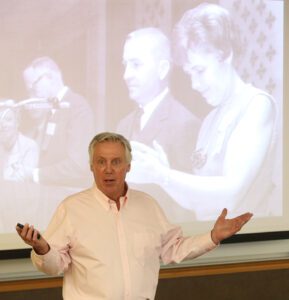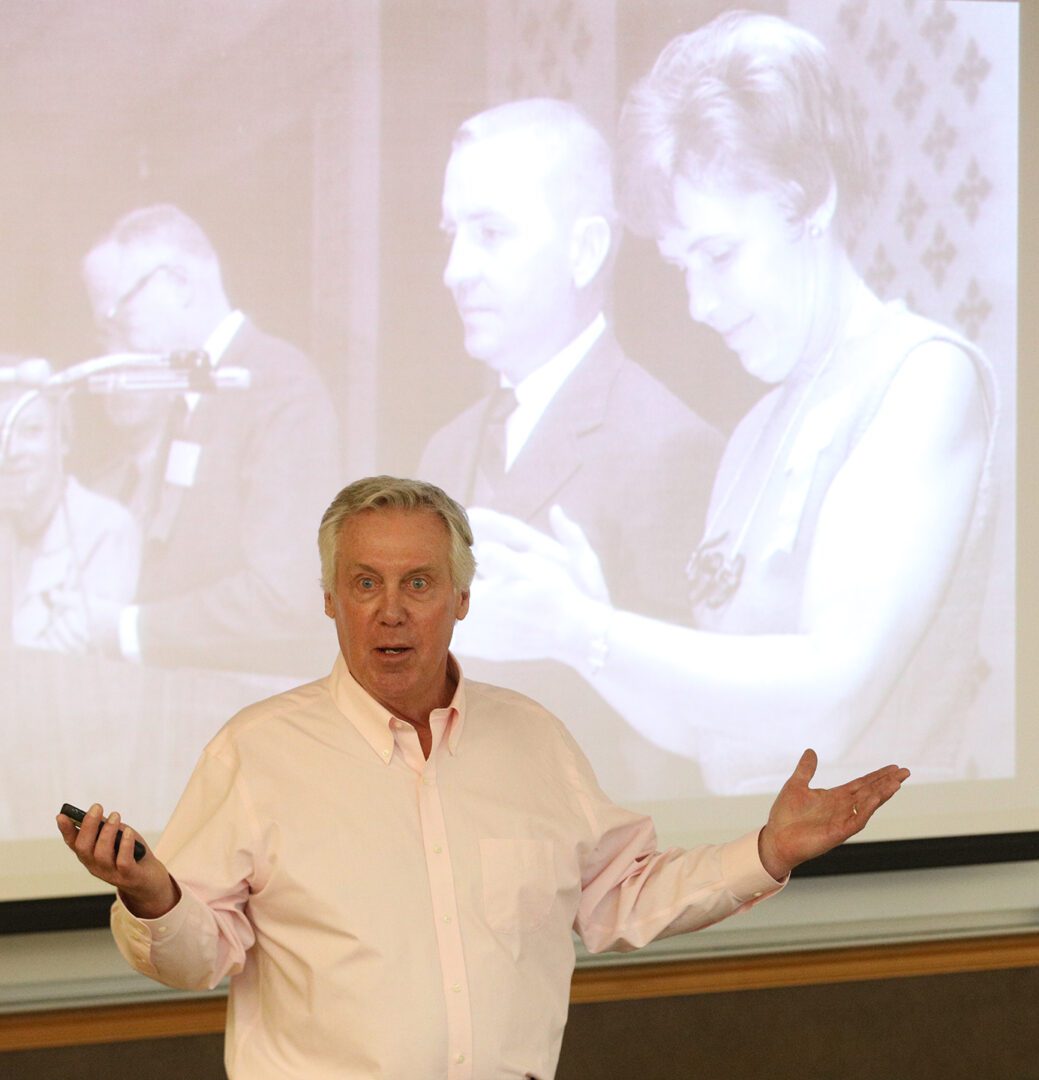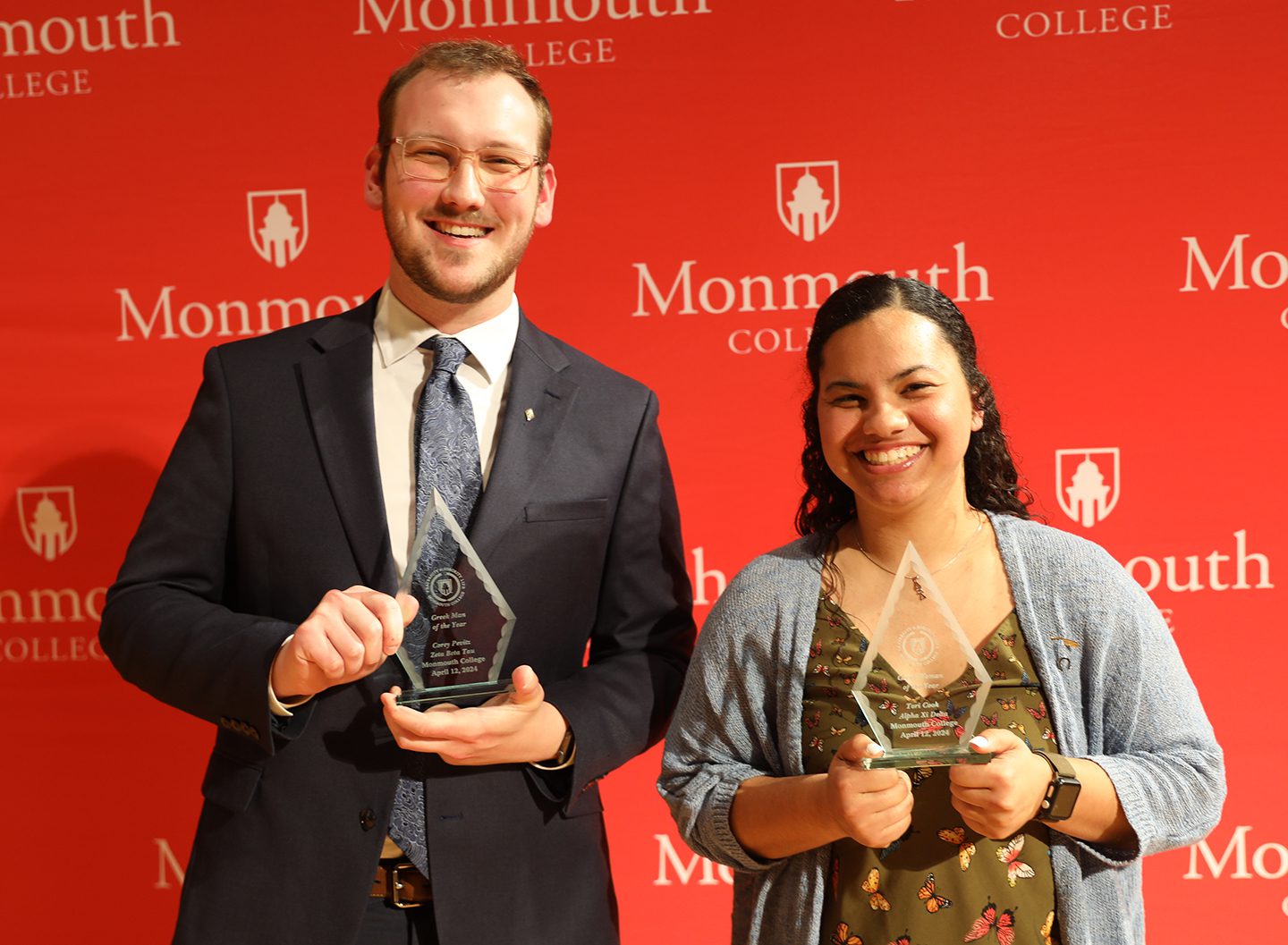JOHN NICOL—MONMOUTH’S MAGICAL PHOTOGRAPHER
Many Monmouth residents are familiar with the exploits of Will Nicol, the Maple City magician who became internationally known for making an elephant disappear. Some have heard of his brother, Charles, also a professional conjurer, who performed under the names Nicoli, Von Arx, the Great Chalbert and Chasan. But few remember their father, John Nicol, whose love for magic inspired both sons.
Today’s photo shows John Nicol in standing on the porch of what he called his “palace car,” a portable photographic studio in a converted wooden railroad caboose, which at the time (circa 1886) was located in the northeast corner of the Monmouth Public Square. Standing at the handwheel is his young son, Will—the future Nicola.
Born in Derry, Ireland, during the potato famine in 1847, John Nicol was one of 10 siblings who emigrated with their parents to Scotland in 1860 and to the United States about five years later. His father, Robert, the story goes, had practiced magic in Scotland and instilled in his son a fascination for illusions. The emerging science of photography provided John with an outlet for his interest—particularly the camera’s ability to capture images that are too quick for the human eye.
Nicol may have learned his trade from William Notman, an amateur photographer in Glasgow, who emigrated to Canada in 1856. Notman opened studio in Montreal and was commissioned to photograph the construction of the Victoria Bridge. When the Prince of Wales visited Montreal in 1860, he was presented with a portfolio of the photographs, which impressed Queen Victoria so much that she proclaimed Notman “Photographer to the Queen.”
Little is known of Nicol’s early days in North America, but he claimed to have served as an assistant to the queen’s photographer in Canada, and proudly styled himself the “Ex Photographer to the Queen.” In 1869, he married Letitia Donaldson in Lake Geneva, Wis., and by the following year he had a studio in Polo, Ill. Previous to locating at Monmouth in 1884, he had a studio at Keithsburg.
A profile of the young photographer was published in the Monmouth Evening Gazette in 1886. The reporter visited him in his art parlor in the northwest corner of the square and found him “as busy as a bee, with orders for pictures amounting to over five hundred, waiting their turn. We have seen many nice photographs in our time, but we must confess that those seen at Mr. Nicol’s are as fine as we ever looked at.”
Although he made his living producing traditional cabinet cards, Nicol’s passion was for what was then termed the “instantaneous process” of photography. This had nothing to do with the Polaroid process; it referred to using a wide lens, a quick shutter and special chemicals to capture an image in a second, rather than what had routinely been several seconds or even minutes.
He spent hours by the C.B. & Q. tracks shooting images of the fast mail train running at 60 miles per hour. One such print ended up hanging in the office of the U.S. Mail superintendent at Chicago. He was most proud, however, of an instantaneous photo he took at the Monmouth fairgrounds on Sept. 14, 1888, when two “roadster” stallions headed in opposite directions collided in front of the grandstand and were both killed, each pierced by a shaft of the sulky to which the other was hitched. The image was widely reproduced and Nicol sold hundreds of prints of the photo.
Despite his fame as a photographer, Nicol never gave up his interest in sleight of hand. As early as 1866, he had been touring Illinois as “Nicoli” and was well known in Monmouth. In that year, he visited a Monmouth barber shop and offered to perform a trick of mesmerism, by asking for two cups, one of which he secretly blackened over a lamp. The barber was instructed to imitate the acts of the mesmerizer and Nicoli lathered his face, carefully using soap only from the center of the blackened cup. To “promote a current,” the cups were exchanged and the barber continued to lather his face until it was black. When he mimicked Nicoli looking into a mirror, he realized the joke was on him.
Nicol’s creativity knew no bounds. Later in his career, he had a photographic background painted showing the ocean and a lighthouse. He obtained a giant shell from Hawaii, which he placed in the foreground. Between the two halves, each weighing 150 pounds, he would place a baby to be photographed.
In 1901, Nicol sold his photo gallery, then located at 201 South Main, to Fleming T. Long. He built a new gallery in an ornate frame building on South C Street, opposite West Park, following which he built a new home on the corner immediately south. His son Charles, who had successfully performed on the Lyceum circuit as Nicoli for several years, joined him in the phtography business.
By the spring of 1903, Nicol’s health began to fail, having suffered for years from kidney disease. He planned to visit a health resort in Michigan, but died in August. His legacy would live on through his magician sons—Will, performing until his death in 1946, and Charles, performing well into his 80s, until his death in 1958.
But the Nicol family’s fame did not end with magic. John’s youngest brother, Hugh, was a star right-fielder for the Chicago White Stockings, St. Louis Browns, Cincinnati Red Stockings and Cincinnati Reds. A base-stealing artist, he is credited with having originated the head-first slide. He played a key role during the Browns’ pennants years of 1885-1886 and later managed the team. He ended his career as Purdue University’s first athletic director.
For Maple City Memories, I’m Jeff Rankin.














